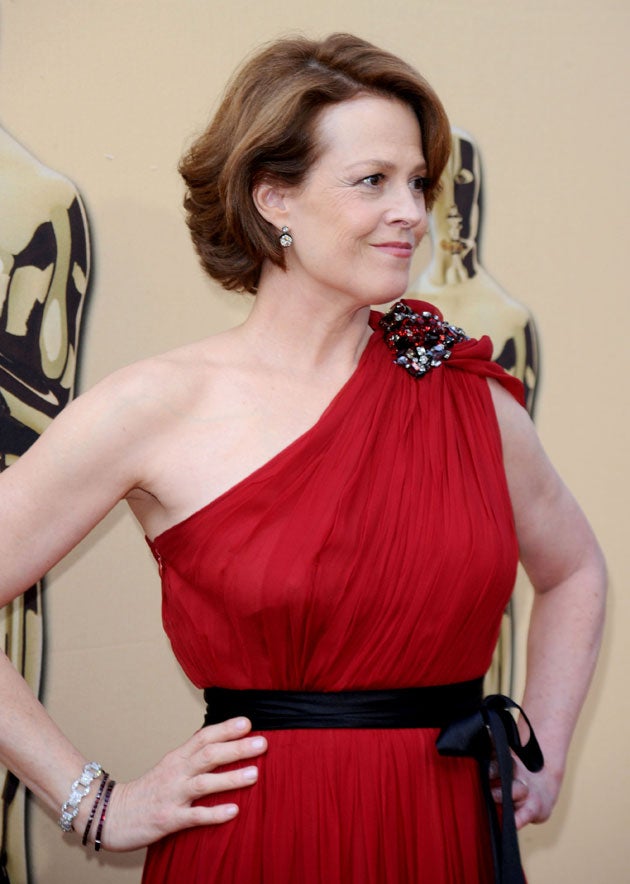You just can't keep a strong woman down
On screen Sigourney Weaveris fearless and Amazonian. Arifa Akbar finds out how the off-screen version measures up

Your support helps us to tell the story
From reproductive rights to climate change to Big Tech, The Independent is on the ground when the story is developing. Whether it's investigating the financials of Elon Musk's pro-Trump PAC or producing our latest documentary, 'The A Word', which shines a light on the American women fighting for reproductive rights, we know how important it is to parse out the facts from the messaging.
At such a critical moment in US history, we need reporters on the ground. Your donation allows us to keep sending journalists to speak to both sides of the story.
The Independent is trusted by Americans across the entire political spectrum. And unlike many other quality news outlets, we choose not to lock Americans out of our reporting and analysis with paywalls. We believe quality journalism should be available to everyone, paid for by those who can afford it.
Your support makes all the difference.The first thing you notice about Sigourney Weaver is her height. Though 5ft 11ins is not extraordinary in itself, it gives her a domineering physical presence which doesn't match her manner – amicable, understated, unstarry.
She sits down, looking not that much changed at 62 from the space-travelling heroine she played in Ridley Scott's Alien, at 30. Yet even with the easy-going smile and soccer-mom outfit (fuchsia-pink shirt, jeans, sensible flat sandals) you can imagine her, if angered, pulling out an alien-zapping bazooka.
Perhaps it is the legacy of her breakthrough role. She has crammed 57 films into the decades since, working with Roman Polanski, Ang Lee and a host of other directors. Yet for many of her fans she will always be best known, and most loved, as Lieutenant Ripley in the Alien quadrilogy. She is quick to point out that "I've only done five science-fiction films", but each has been considered groundbreaking in its own right, which might be why she is sometimes seen as an unofficial ambassador for sci-fi.
Before Alien a female lead in a sci-fi film was about as rare a sight as a snow leopard in summer. Weaver is credited with bringing feminism to Hollywood, and she has continued to play the brainy, ballsy, "strong woman" survivor. There was feisty zoologist Dian Fossey in Gorillas in the Mist and the principled scientist in James Cameron's Avatar. Next month she can be seen as a no-nonsense assistant district attorney, opposite Woody Harrelson's renegade cop, in Rampart .
As typecasting goes, the strong woman stereotype can't be a bad ghetto to be stuck in? Weaver is not so sure about the feminism theory behind Alien. She thinks Ripley was a shrewd plot surprise by studio executives at Fox whose noses were led by the box-office, not Girl Power. "I don't think the producers were feminists. In the original script, they were all men. I think they thought, 'Let's change it up and make the survivor a woman because no one will ever think the survivor will be a woman.'"
What Alien and Ripley became was a mirror for gender shifts outside Hollywood: "I think it was taking the pulse of society at that moment; we were another expression of how our world was changing. Women were agitating to be in the army, to work in warehouses and as truck drivers."
The glass ceiling is still there for actresses as it is for women in all sections of society, she says, but it is a more textured, less depressing picture now than it used to be when her mother, English actress Elizabeth Inglis, sacrificed her career for raising a family. Weaver, by contrast, has been a working mother ever since her daughter Charlotte Simpson was born in 1990.
The making of Avatar, and of its sequel, which is already under way, made her rethink the future of movies: its radical new technology means actors are performing in a blank space, with no diversions or distractions (the scenery and special effects were visible on monitors nearby). The experience was a gratifying one, more like a theatre rehearsal than the stop-start of conventional filming, and it also made her see the limited lifespan of 2D films. "I think 2D is going to be like black-and-white soon because 3D is the natural way that people encounter life, so it's a revolution the way that Greco-Roman sculpture was after hieroglyphics.
"It's the future, but it will be a while before people can achieve 3D consistently in a way that puts you in a world of the story in a seamless way. That's the object: to immerse you in a world, not to trick you or entertain you. And that's why it's more important perhaps for a regular movie; you should be in their world – whatever they say and decide and think should mean more to you because you can't divorce yourself. I'm excited to go back to Avatar. I know the story that James Cameron wants to tell is so much bigger."
Rampart is released on 10 February
Join our commenting forum
Join thought-provoking conversations, follow other Independent readers and see their replies
Comments